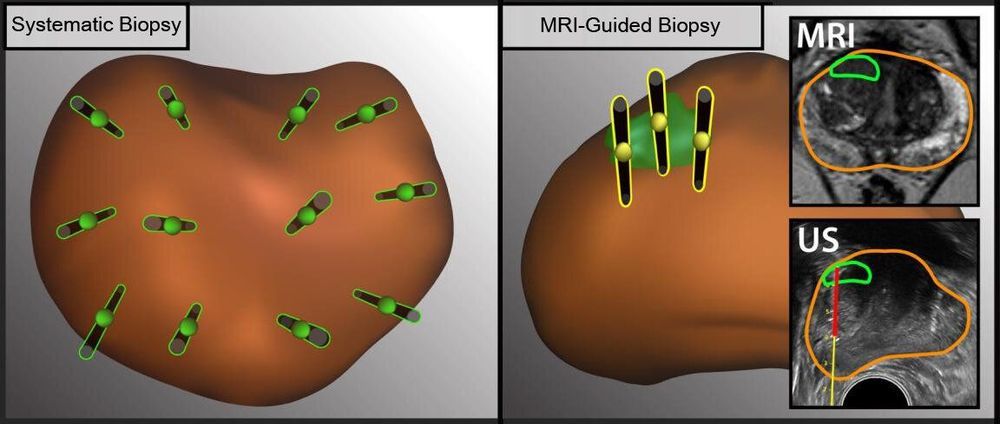A discovery by researchers at the School of Life Sciences at the University of Warwick offers a new technology for detecting bacteria in minutes by ‘zapping’ the bacteria with electricity.



Each year, 1 million men in the U.S. undergo biopsies to determine whether they have prostate cancer. The biopsy procedure traditionally has been guided by ultrasound imaging, but this method cannot clearly display the location of tumors in the prostate gland.
A multidisciplinary team of UCLA physicians has found that a new method, which includes biopsy guided by magnetic resonance imaging, or MRI, can be used together with the traditional method to increase the rate of prostate cancer detection.
Ultrasound has been used to visualize the prostate in order to take a representative sampling of tissue to biopsy. The introduction of MRI has allowed doctors to see specific lesions in the prostate and only take tissue samples from those spots. But the two sampling methods often aren’t used in combination.
Isaac Asimov referred to a 70-old man as an old individual who is unlikely to live much longer. Yet, given the present pace of discovery in the ageing field, the pace of ageing could be slowed within our lifetime, with science surpassing science fiction.
Thus, genetic studies have now firmly established that aging is regulated by specific genes conserved from yeast to mice [23,30–34].
Independently of discoveries of AP genes in model organisms, research in cellular senescence yielded complementary results. Cellular senescence is now widely recognized as an essential tumor suppressor mechanisms, and is not a decline due to cellular degeneration. In contrast, the senescence response is an active process caused by activation of both DNA-damage responses (DDR) and mitogen-activated pathways. Senescent fibroblasts acquire phenotypes that include hyper-secretion of inflammatory cytokines and other tissue-altering molecules and hypertrophic morphologies [35–42]. Senescent cells can alter the behavior of neighboring cells [35], and may drive aging and age-related diseases [43]. Cellular senescence can be prevented by knocking out cell cycle inhibitors such as p53, pRb, p21 and p16 [44–48].
I recently came to an important realisation: I will most likely see the so-called Singularity happen in my own lifetime. I’m 56, at this time, and I believe that the inflection point at which computers, ‘thinking machines’ and AI may become infinitely and recursively powerful is no more than 20–25 years away, at most — and it might be as soon as 12–15 years from today.
We are at ‘4’ on the exponential curve, and this matters a lot because doubling a small number such as 0.01 does not make much of a difference while doubling 4–8–16–32–64 is another story altogether: timing is essential, and the future is bound to increasingly happen gradually, then suddenly.
Liz in this video is speaking to the mormons. THE MORMONS do not care a lot for me. Mostly due to when they push their thoughts that are wrong I push back. {I dealt with one of their prophets Years ago} and some of the minds of this day, their wrong-thoughts are the same as in 2003–4. When one is adjusting their comments, they then freak out and begin attacking your truth that moved their comments-thoughts out of the way. The truth will cut you loose. Respect r.p.berry & AEWR wherein the many causes of aging have been found and a cure located by our Data research. We search for partners-investors to now join us in agings end…
At the 2018 Conference of the Mormon Transhumanist Association, held 7 Apr 2018 at the Marriott Hotel and Conference Center in Provo, UT, speakers addressed the themes of Mormonism, Transhumanism and Transfigurism, with particular attention to topics at the intersection of technology, spirituality, science and religion. Members, friends and critics of the association have many views. This is one of them. It is not necessarily shared by others.


A team of researchers at Stanford University has found synapse-boosting factors in the blood of young mice. In their paper published in Proceedings of the National Academy of Sciences, the group describes their study of the rejuvenating impact of blood from young mice when transfused into older mice, and what they learned about it.

Scientists have figured out how to use a laser to transmit audio, ranging from music to speech, to a person across a room without any receiver equipment — a potential breakthrough for the future of audio and communication.
“Our system can be used from some distance away to beam information directly to someone’s ear,” Massachusetts Institute of Technology research Charles M. Wynn said in a press release. “It is the first system that uses lasers that are fully safe for the eyes and skin to localize an audible signal to a particular person in any setting.”

A measles epidemic has been declared in the Democratic Republic of the Congo, a country struggling to contain the world’s second-largest and second-deadliest Ebola outbreak.
Add Measles as an interest to stay up to date on the latest Measles news, video, and analysis from ABC News.

A team of researchers with the Royal Botanic Gardens in the U.K. and Stockholm University has found that plant extinctions over the past two and a half centuries have been more extensive than previous estimates suggested. In their paper published in the journal Nature Ecology and Evolution, the group describes their exhaustive study of plants and which have gone extinct, and what it might mean for future plant life.
In recent years, botanists have estimated that fewer than 150 plant species have gone extinct in modern times—most due to human activities. In this new effort, the researchers have found that the real number is closer to quadruple such estimates—they found 571 plants that have gone extinct since 1753. That was the year that famed botanist Carl Linnaeus published his Species Plantarum—a collection of all known plant species at that time. The researchers also claimed that approximately three species of plants have gone extinct on average each year since 1900—a rate that they note is approximately 500 times the natural rate of plant extinction. The group came to these conclusions using information from a database started back in 1988 by workers at the Royal Botanic Gardens who have had the goal of adding every known plant on the planet. Since that time, over 330,000 plant species have been added.
The researchers also created a map showing where the extinctions have occurred, noting that most are in the tropics and on islands. The map also highlights some interesting hotspots as well, such as South Africa, Australia, India and Hawaii. They add that the main culprit is habitat destruction, though some have also suffered from being too popular with humans—the Chile sandalwood tree, for example, was harvested for its exotic aroma.